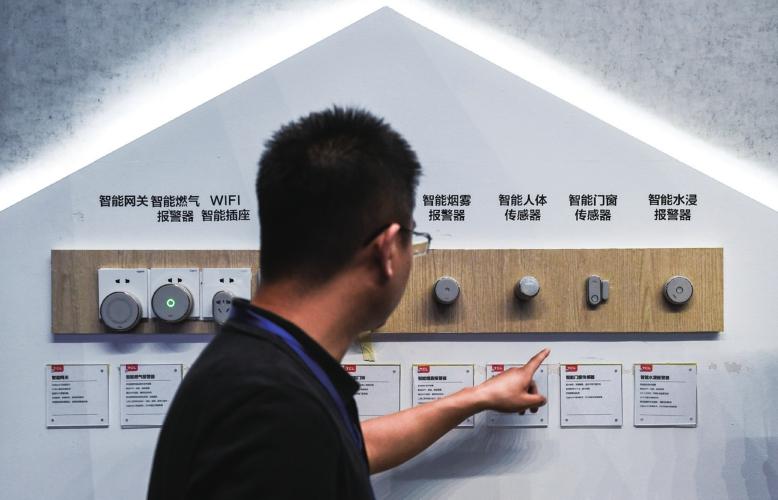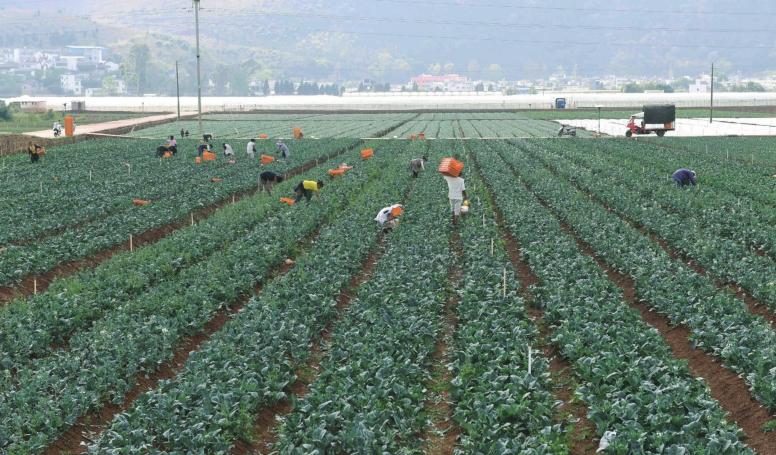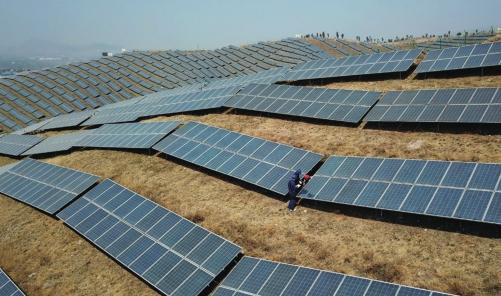Home,Smart Home
2019-04-18

Home, Smart Home
A visitor tests a smart home system during the Seventh China Information Technology Expo in Shenzhen, south Chinas Guangdong Province, on April 9.
China-Africa Ties
Experts and scholars from Africa lauded the great importance Chinese President Xi Jinping attaches to Chinas ties with the continent, saying a newly established institute will contribute greatly to the development of bilateral ties.
At the inauguration of the China-Africa Institute on April 9, Xi reiterated in a congratulatory letter the time-honored friendship between China and Africa and the global signifi cance of their relations.
He urged the institute to draw on academic resources from both sides, enhance mutual understanding and friendship, and provide ideas and advice for China-Africa cooperation.
Hoze Riruako, a political analyst and lecturer in political science at the University of Namibia, said Xi attaches great importance to the establishment of the China-Africa Institute.
Recalling the joint decision by the two sides to build a closer ChinaAfrica community with a shared future, Riruako said the new body will help increase people-to-people exchanges and consolidate bilateral connections across various fi elds.
He expressed hope that the institute will serve as a bridge for China-Africa dialogue and cooperation and that with people-to-people exchanges increasing, more chances will be available for African students to pursue further education in China.
Nasser Bouchiba, President of the Africa-China Cooperation Association for Development, said he believes that the institute will provide a solid foundation for the theoretical research needed to boost ties.
Sheriff Ghali Ibrahim, a professor of political science and international relations at the University of Abuja in Nigeria, said the establishment of the institute is an important step toward building a closer China-Africa community with a shared future and shows Chinas sincerity and determination in improving communication and understanding between the two sides.
Silas Lwakabamba, Rwandas former Minister of Education, said the institute will help African think tanks deepen research on Chinas development and learn from Chinas experience, and enable China to better understand Africa.
Old-Age Industry
Elderly Chinese citizens need better old-age care services, with family support favored by most seniors and community-support and nursing homes growing fast, according to an industry report.
To understand the countrys old-age care industry, analysts with the Qianzhan Industry Research Institute (QIRI) suggested investors remember the number “9073.”
According to the QIRI report, the number offers investors a better clue of the general segmentation of Chinas elderly care services, as 90 percent of seniors rely on family support, 7 percent on residential community-based care services and 3 percent on nursing homes.
Citing statistics from the National Bureau of Statistics, the report projected a huge market potential. As of the end of 2018, the total number of Chinese seniors (60 and above) reached 249.49 million, and it is expected to surpass 300 million in 2025.
By the end of 2018, there were only 29,800 registered senior care institutions with 3.98 million beds in the whole country. If 3 percent of seniors live in senior care institutions in 2025, the total number of beds should surpass 9 million, the report said.
Meanwhile, the country needs more products for the elderly. According to a survey on urban and rural seniors released in October 2016, some 65.6 percent of seniors used products specially designed for the elderly. Among this consumer group, 46.8 percent of them used presbyopic glasses.
False teeth, blood pressure monitors and walking sticks are used by 27 percent, 14.2 percent and 9.3 percent of the senior population, respectively.
Other popular products include blood sugar monitors, massage equipment, wheelchairs, hearingaids and adult diapers, said the report.
Fighting Desert
Inner Mongolia Autonomous Region, lying at the forefront of Chinas fi ght against desertifi cation,will afforest over 860,000 hectares in 2019, local authorities said on April 9.
In recent years, Inner Mongolia has completed an afforestation project covering more than 666,700 hectares every year, accounting for one ninth of the national total.
The regions afforestation efforts will consolidate its role as an important ecological barrier protecting north China, said Mu Yuan, Director of the regional forestry and grassland bureau.
The region will also plant over 2 million hectares of grass this year.
The ecological restoration of major grasslands and the quality of afforestation have also been highlighted. Data shows that Inner Mongolia now has more than 26 million hectares of forests. Its forest coverage rate has risen by 1.07 percentage points to 22.1 percent from 21.03 percent in 2013.
Inner Mongolia is home to several large deserts such as Badain Jaran, Tengger, Ulan Buh and Kubuqi. The reduced number of sandstorms in north China has been credited to taming desertifi cation over recent decades.
Phone Obsession
An article in Peoples Daily said if someone in a relationship spends too much time on his or her phone and becomes estranged from and causes mental harm to their partner that can now be classifi ed as a form of domestic violence.
Mobile phones have deeply penetrated peoples lives, the newspaper said, noting that people clutch at their phones almost whenever they are awake, even when they are with someone else.
“Social media, taking pictures, payment, navigation... The continuous fl ow of information is like bait being spread around a fi sh that makes the fi sh too busy to focus on one thing,” the newspaper read.
The newspaper cited an AllChina Womens Federation report that 43 percent of the respondents said they use smartphones or tablet computers at family gatherings. The more frequently they use mobile devices before going to bed, the lower their satisfaction rate of marriage.
In Full Bloom
Tourists take photos during a fl ower exhibition at the Slender West Lake in Yangzhou, east Chinas Jiangsu Province, on April 8. During the exhibition, over 200,000 fl owers festooned the park.
Large City Residency
China will ease the requirements for permanent residency in many large cities as part of its new urbanization push.
Restrictions on permanent residence permits should be scrapped in cities with populations between 1 million and 3 million, according to a document outlining key urbanization tasks this year released by the National Development and Reform Commission (NDRC), the countrys top economic planner, on April 8.
For cities with populations of 3 million to 5 million, the qualifi cations for such permits should be“fully relaxed,” and the restrictions for certain key groups of people to get such permits should be removed, the document said.
Previously, the country has already gradually abolished permanent residency restrictions in small and medium-sized cities and towns with populations below 1 million.
The NDRC document also demanded cities with populations above 5 million to improve their policies and drastically expand the scale of permanent permits.
While fast urbanization in China has caused large population fl ows from rural to urban areas, only those registered with permanent residence permits are fully entitled to social welfare in their resident cities.
Basic public services should be guaranteed for unregistered permanent residents in cities, with an increased supply of education resources in cities where there are a sizable number of children of migrant workers, according to the NDRC document.
Picking Tea
Foreign students pick tea leaves at a tea garden in Lushan, east Chinas Jiangxi Province, on April 8. Fifty foreign students came to an ecological tea garden in Lushan to experience traditional tea culture of China.
Financial Court
The Shanghai Financial Court has accepted nearly 2,900 cases since its establishment in August 2018, with the total amount of claims surpassing 40 billion yuan ($6 billion).
Xiao Kai, the courts vice president, revealed the fi gure on April 7, at a symposium on globalization, peaceful development of China and major transnational litigation in Shanghai.
The court is the countrys fi rst to specialize in handling fi nancerelated cases.
Xiao said the main types of cases accepted by the court were disputes involving securities, fi nancial borrowing contracts, corporate bond trading, fi nancial lease contracts and business trust.
“On the one hand, the court needs to resolve a large number of cases involving fi nancial disputes; on the other hand, it needs to truly play the role of fi nancial judge by making ‘great judgments on fi rst, complex and typical cases, so as to stabilize market expectations and enhance the market order and rule,”Xiao said.
William Blair, former judge in charge of the London Commercial Court of the High Court of England and Wales, said at the symposium that the Shanghai Financial Court will make a very important contribution because it is a specialist fi nancial court.
“This will help contribute to fi nancial stability and will make Chinese fi nancial law better understood worldwide,” he said.
Lower Tax Rates
China will lower the tax rates on a range of goods brought or mailed into the country by individuals, including food, medicines, textiles and information technology products, the Customs Tariff Commission of the State Council announced on April 8.
Starting on April 9, the tax rate on inbound articles included on the No.1 taxable item list, which includes books, computers, food, furniture and medicines, will be reduced to 13 percent from the previous 15 percent, the commission said in an online statement.
Some medicines that are currently subject to a 3-percent import value-added tax rate, including anticancer drugs and medicines for rare diseases, will enjoy a favorable tax rate.
The tax rate on No.2 taxable items, including some sporting goods, textiles, electronic appliances and bicycles, will be lowered to 20 percent from the previous 25 percent, it said.
The move was aimed at expanding imports and boosting domestic consumption, with tax rates lowered for many daily consumer goods, the commission said.
Greener Pastures
Farmers work in a vegetable fi eld in Mile, southwest Chinas Yunnan Province, on April 8. Local distinctive vegetables have been sold widely across China, helping greatly improve farmers income.
Innovation Boom
China is catching up with the U.S. in innovation, according to the indicators shown in a U.S. think tank report released on April 8.
During the past decade, China has been closing the gap with the U.S. rapidly and now even leads in some instances, says the report published by Information Technology and Innovation Foundation (ITIF). In 2007, Chinas investment in R&D was 33 percent less than that in the U.S. But by 2017, China had signifi cantly closed the gap by reaching 76 percent of U.S. levels and surpassing the EU, according to the report.
Chinese government institutions spent more on R&D as a share of GDP than the U.S., going from 84 percent of U.S. levels in 2007, to 119 percent in 2017.
Chinese venture capital markets were extremely small in 2006, 3.7 percent of U.S. venture capital funding. But in 2016, venture capital fi rms in China provided half as much funding as the fi rms did in the U.S.
Chinas research universities scored just 9.5 percent of that of the U.S. in 2009, but closed the gap to 28 percent by 2018, based on the Shanghai Academic Ranking of World Universities.
Also, Chinas hi-tech manufacturing value added grew from 30 percent in 2006 to 77 percent in 2016. If this growth rate were to continue, China would exceed the U.S. in hi-tech manufacturing value added by 2020.
Optimistic Outlook
Chinas small businesses are cautiously optimistic amid the anticipated global economic downtrend in 2019, China Daily reported on April 10, citing an industry report.
The result of the performance of small businesses on the Chinese mainland elevated the survey average, with 74 percent of them stating that they grew in 2018, higher than the survey average of 66 percent, said Derek Chan, President of CPA Australia North China Committee, adding that the positive c onditions would continue in 2019.
The fi ndings follow extensive surveying of more than 3,600 small business operators in 10 markets, including Australia, China, Indonesia, Malaysia and the Philippines. It was conducted by CPA Australia, one of the worlds largest accounting bodies.
The survey showed increasing costs are one of the most signifi cant barriers to small business on the Chinese mainland, with over 33 percent of the surveyed identifying it as a key challenge.
To help ease companiesburden, China introduced a series of tax reforms last year and plans to reduce the tax burdens and social insurance contributions of enterprises by nearly 2 trillion yuan ($298 billion) this year.
Chan considered the governments announcement during this years Two Sessions on increasing the availability of fi nance for small businesses as a timely measure, which will further improve small businesses access to fi nance.
Trade Feast
A visitor tries out a new-energy car at the China International Investment and Trade Fair held in Zhengzhou, central Chinas Henan Province, on April 8. More than 15,700 business delegates, including 2,566 from overseas, took part in the fair.
Growth Forecast
The International Monetary Fund(IMF) revised the 2019 growth projection for China on April 9, up to 6.3 percent, 0.1 percentage points higher from its previous estimation in January, according to the newly released April 2019 World Economic Outlook (WEO).
The upward revision refl ected the combined impact of recent developments in China-U.S. trade talks, Chinas stronger-thanexpected expansionary fi scal policy and a slowing global economy, Changyong Rhee, director of the IMFs Asia and Pacifi c Department, told Xinhua News Agency.
In its latest annual government work report, China set its 2019 GDP growth target at 6-6.5 percent. The worlds second largest economy also pledged to continue pursuing high-quality development.
The IMFs medium-term forecast sees a gradual slowdown in China “as internal rebalancing toward a private consumption and services-based economy continues and regulatory tightening slows the accumulation of debt and associated vulnerabilities.”
The latest WEO report projected a 6.1 percent growth rate for China in 2020, slightly down from the previous estimation of 6.2 percent.
Powering Power
Staff members work at a photovoltaic power plant in Shijiazhuang, north Chinas Hebei Province, on April 8. In recent years, the city has started using solar power, greatly accelerating the development of clean energy.

Fighting Piracy
Chinas e-commerce giant Alibaba has created a project for “video fi ngerprints,” a technology that gives each original video a unique online identity, to fi ght piracy on its ecommerce platforms.
Short videos have become a popular form of advertisement for sellers on Alibabas e-commerce platforms Taobao and Tmall. But the frequently updated videos are often left unpatented due to a long application process of 10 to 30 days, facing increasing risks of being used by other sellers.
To curb the new type of piracy, Alibabas security lab has created“fi ngerprints” for all original videos on Taobao and Tmall based on characteristics such as coding and compression of each frame, said He Yuan, a senior algorithm expert at the lab.
Businesses participating in the project can upload their videos and have “fi ngerprints” generated automatically, which are then compared against the database with hundreds of millions of videos across the platforms to determine if it is the original.
After being online for about a month, more than 7,000 businesses have signed up to participate in the project. More than 1 million short videos lasting 20 to 30 seconds can be examined each day, according to Alibaba.
